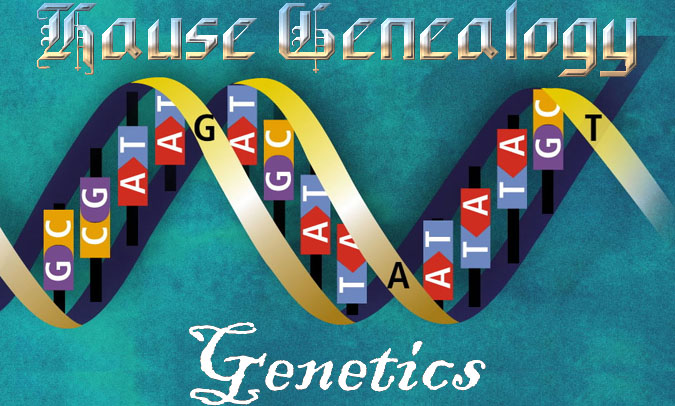
|
"Wait a minute!!! I'm 62% British, 19% Scandinavian, 8% Persian, and 7% Southern European? I'm supposed to be German!"
—This Author
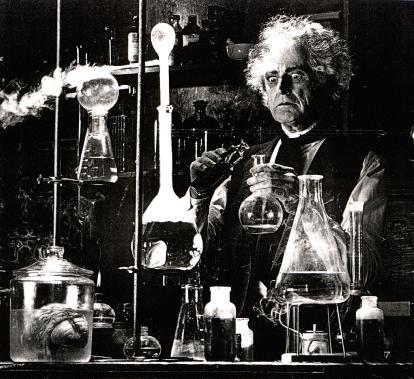 |
We have inherited different sections of our DNA from different ancestors, but as we look back through time, the number of ancestors almost doubles with each generation ("almost" because we are all somewhat inbred). Going back only ten generations in our genealogy—between 200 and 300 years, depending on the family—we have 1024 ancestors (which is a lot more names than will fit in your family bible).
|
To learn how our families branched off from those common ancestors and made us who we are, a DNA test can look at a our genetic code at specific locations on our DNA chain and trace our results to others from the same lineage, location and/or ethnic group. To achieve this, different ancestry tests look at different types of DNA:
|
TYPES OF DNA TESTS |
|
 In January of 2013, I took an autosomal (atDNA) test with Ancestry.com. The AncestryDNA Service can be used in conjunction with the Ancestry family of websites to enable to utilize Ancestry.com's family tree services in conjunction with their test results. AncestryDNA Users may also communicate with each other in order to collaborate and exchange family history related information. AncestryDNA uses advanced scientific techniques to measure and analyze a person's entire genome at over 700,000 locations. During the testing process, each DNA sample is held to a quality standard of at least a 98% call rate.
In January of 2013, I took an autosomal (atDNA) test with Ancestry.com. The AncestryDNA Service can be used in conjunction with the Ancestry family of websites to enable to utilize Ancestry.com's family tree services in conjunction with their test results. AncestryDNA Users may also communicate with each other in order to collaborate and exchange family history related information. AncestryDNA uses advanced scientific techniques to measure and analyze a person's entire genome at over 700,000 locations. During the testing process, each DNA sample is held to a quality standard of at least a 98% call rate.
Ancestry.com offers a full genome—or autosomal—test that analyzes 22 of 23 chromosomal pairs. Whereas older consumer DNA tests utilized only 46 DNA markers, this new test analyzes more than 700,000 DNA marker locations and cross-references them with a comprehensive worldwide catalogue of DNA samples. It looks at both maternal and paternal lines, and works just as well for men and for women. According to the website:
|
AUTOSOMAL DNA (atDNA) TESTING |
WHAT GETS TESTED: Generally, a genealogical DNA test might use either autosomal STRs or autosomal SNPs. (STR's are Short Tandem Repeats; SNP = single-nucleotide polymorphism.) However, testing companies do not currently offer autosomal STRs tests that use enough STR markers for genealogy. Some ethnic population matching products use them. The preferred choice for both genealogy and ethnic population matching is microarray chips that use hundreds of thousands of autosomal SNPs.
MATCHING PROCESS: There are currently two types of matching processes used. The first is haploblock matching. This process counts the number and size of matching runs of DNA from one point to another. It then computes the likely number of generations between two people. The second method is biogeographical analysis. This method seeks to match individual SNP values' frequencies in reference populations to match geographic origins. |

|
There are currently two types of matching processes being used:
 |
This method seeks to uncover my geographic origins. This is done by comparing the frequency of each Autosomal DNA marker tested to many population groups. The first result is my Genetic Ethnicity Summary, which supposedly reveals the general areas where my ancestors lived "hundreds—perhaps even thousands—of years ago." The results show me as 31% Irish, 30% Western European, 14% Scandinavian, 12% British and even Asian (although less than 1%).
It's fun, but many scientists have criticized ethnic ancestry tests like this for promising more than they can deliver. So the truth is, saying where, and in what ethnic group, that you come from is mostly speculative. Inevitably this speculation comes down to "interpretative phylogeography"—an approach to "reading" our genetic history that can easily steered by subjective biases, has never been scientifically shown to work, and—in some forms—has been explicitly shown not to work.³ My first results in 2013 showed that I was 62% British, 19% Scandinavian, 8% Persian, and 7% Southern European. I bellowed, "Wait, I'm supposed to be German!" But any ancestral "history" identified by a simple genetic test is just one of dozens of possible interpretations. I had records of ancestors coming from Hessen, Berlin, and the Black Forest, so I knew there was a problem. Fortunately as more people have been tested from all over the world (going from tens of thousands then to millions now), the characteristics of each region and its native people have become much more defined, the results have become much more specific with improved accuracy.
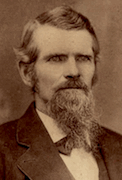 |
In the first batch of results, I was able to verify descendancy from my paternal 6th great-grandfather William Hause (1750-1818), and his wife, Martha Wood. Below is a DNA match connecting me to a fifth-cousin (three times removed) by way of my 7th great-grandmother, Johanna Crompton (b. 1725), the mother of Martha. My newly-discovered cousin is descended from Martha's sister, Susannah Wood (b. 15 Jan 1757). We were both notified of a DNA match predicting that we were 4th-to-6th cousins, and then Ancestry.com automatically found this common ancestor in our family trees, within that range. My lineage is on the left, and her lineage is on the right:
 |
This next match connects me with a 6th cousin, 1x removed, through William and Martha Hause, themselves. This cousin is descended from their son, William Jr.:⁴
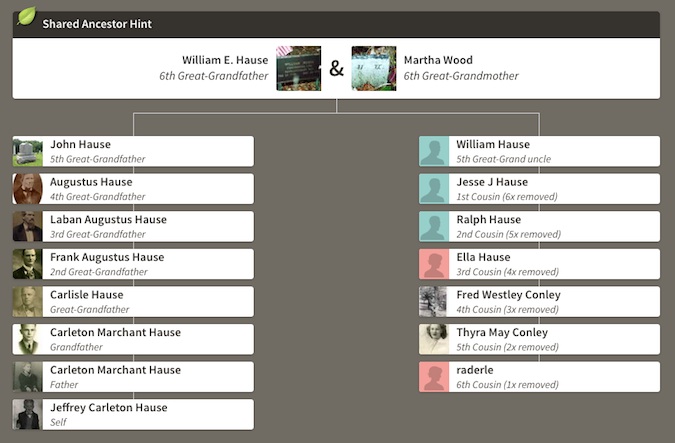 |
Another match connects me with a 5th cousin (2x removed) through William and Martha Hause by way of their sons John Hause (1773-1844), my 5x Great-grandfather, and Matthew Hause (note the spelling change to "Hawes" in the following generation):
 |
This match connects me with another 6th cousin through William and Martha Hause's son, John Hause (1773-1844), my 5x Great-grandfather (I'm also a match with this guy's mother Dawn Hullings, my 5th cousin 1x removed, from Penn Yan, New York—which is definite Hause country):
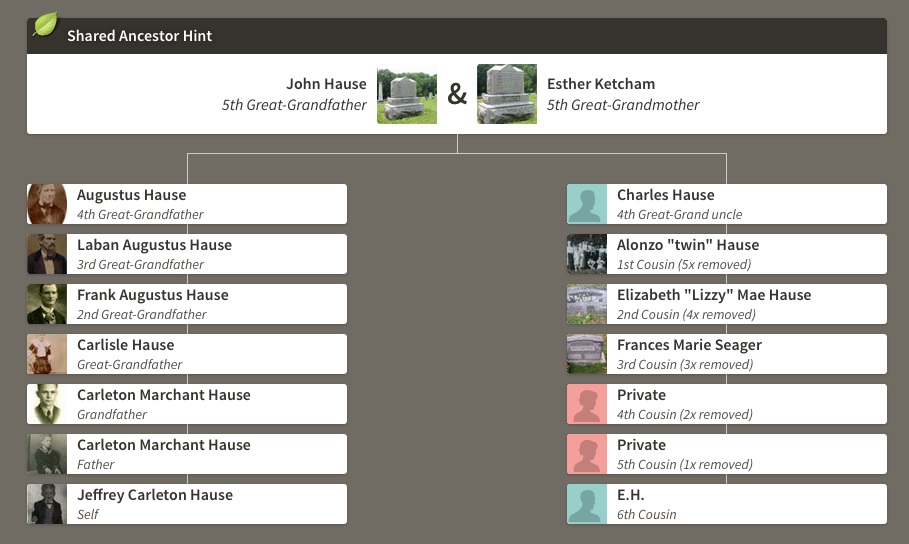 |
And a 5th cousin (1x removed) who is another descendant of John and Esther:
 |
Here's an important match for a maternal line of my family, that predicted a relationship in 5th-8th cousin range. It connects me with a 6th cousin 1x removed, descended from my 6th great-grandfather, Joseph Munyon (1712-1797), the grandson of the poor couple whom I now can be fairly sure are my 8th great-grandparents, John Proctor (1632-1692) and Elizabeth Bassett (1650-1693), famous for being convicted as witches at the Salem witch trials. John was actually executed, while Elizabeth and Joseph's mother were spared. The Proctors also became the main characters in Arthur Miller's play The Crucible. This anecdote had only been a rumor/story in my family up to now (apparently being related to convicted witches wasn't something you bragged about back then):
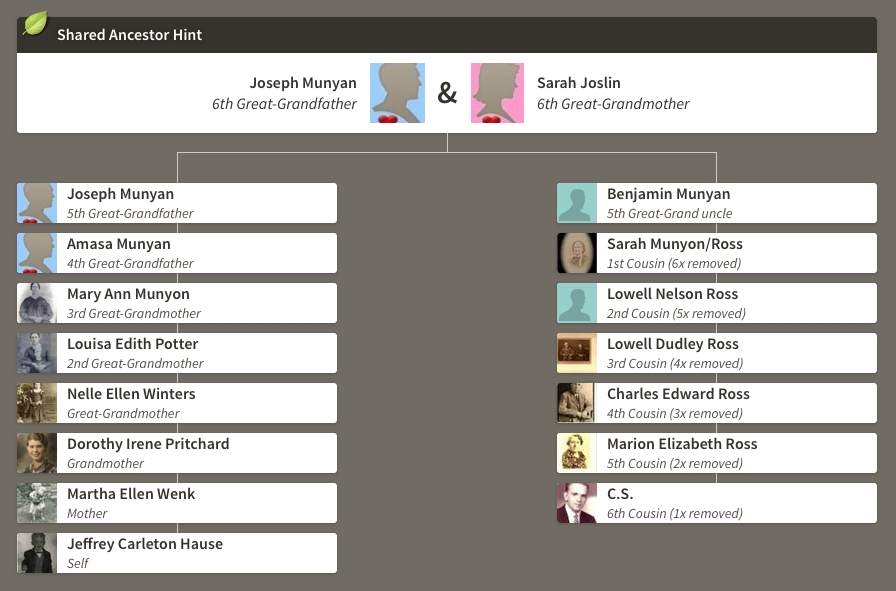 |
Still, I wasn't sure if this was proof, or just a lucky coincidence in the family trees of two amateur genealogists... but then came another match, through his son Joseph II (1747-1831).
Then came yet another match, also in the 5th-8th cousin range, connecting me with a 7th cousin through Joseph's father-in-law and Joseph II's maternal grandfather, Israel Joslin (1693-1761):
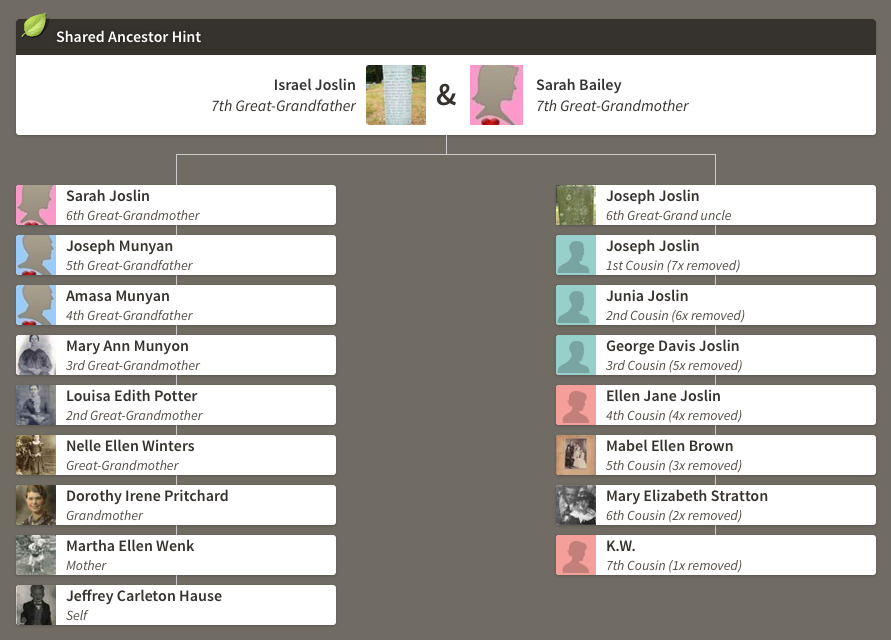 |
Still not convinced? Here's a second match to Israel, also through a line of descendancy from Joseph Joslin, like the one above, but running through his daughter, Mary. You want more proof, bitches (or witches)? Here's yet another match to Israel Joslin through a different child, Benjamin. That's four distinct DNA matches from different ancestors in that line, so I believe it's proven that we're descended from the Joslins and Munyans, and therefore, the Proctors (if you still want to argue, just be careful... remember that I'm descended from witches).
But wait, there's more! I soon had other DNA matches to different ancestors, including a connection to a third cousin, once removed, who descended from my 3rd great-grandfather Albert Julius Raymond (6 Sep 1848 - 12 Nov 1924), whose Michigan unit in the Civil War captured Confederate president Jefferson Davis, to end the conflict (both branches of the family are pretty proud of this heritage):
 |
And another cousin, also descended from Albert's son, Julius, and her granddaughter. After this one, AncestryDNA declared us all a confirmed genetic match.
Then came the parents of Albert's wife, my great, great, great-grandmother Lois Matilda Kilbourne. I connected to the person below, and her mother, who also took the test:
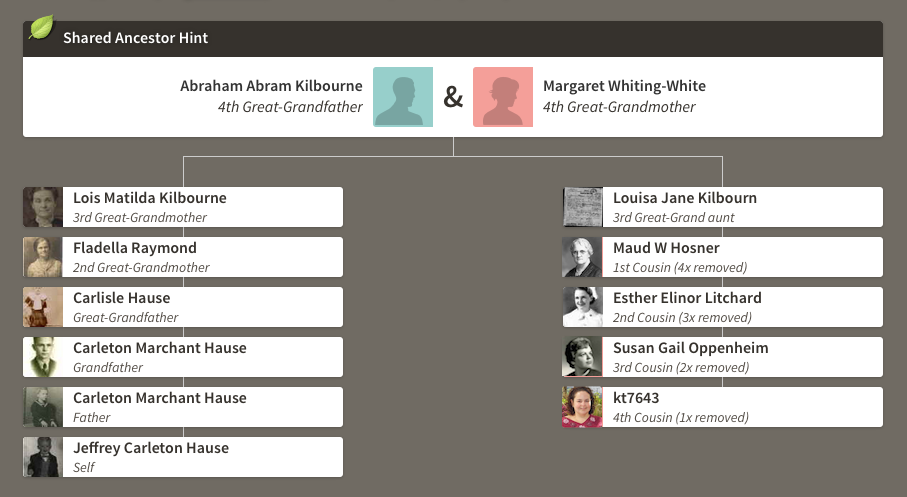 |
From there, we go to a 2nd cousin 1x removed, descended from Albert's daughter, Fladella (my great, great grandmother), and Frank Hause, my paternal great, great grandfather (this connection's sister was also matched to me genetically, but she hasn't put a family tree on the site to show the actual connection):
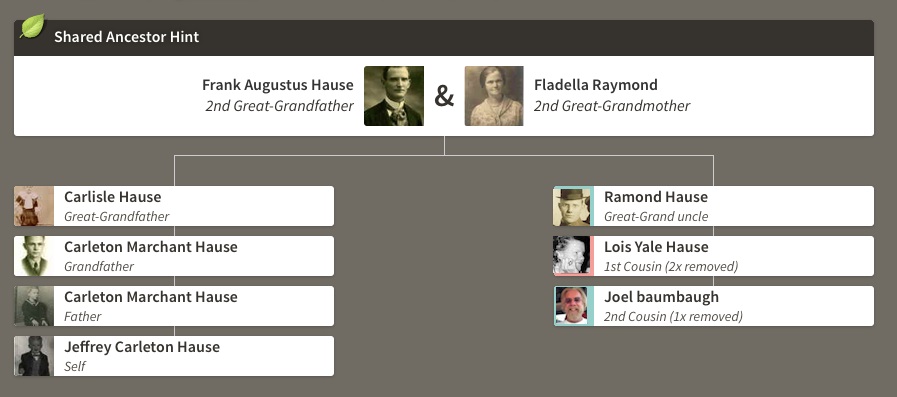 |
Here's a genetic link to my 6th Great-Grandfather, John Bright (or Johannes Brecht, a 2nd generation German immigrant), who was born 20 Feb 1735/36 in Heidelberg, Berks County, Pennsylvania, married Margaret Schaeffer and died around 1817 in Jonestown, PA. John fought in the Revolutionary War, and is listed as taking the Oath of Allegiance, 1777-78, in Schaefferstown with his two sons, Jacob and John, and his brother-in-law, Alexander Schaeffer. John was in the Eighth Regiment of the Continental Line from Pennsylvania. My connection is through a 6th cousin 1x removed:
 |
There are more connections to the Brecht/Bright family. Here's one through John's brother David and their father, Johann Michael Brecht (30 May 1706 - 13 Sep 1794), my immigrant ancestor in this line. Finally, another match with a cousin by way of John's son, my 5th great grandfather Michael Bright (10 Sep 1762 - Mar 1847, and German, by the way), who owned a farm near the the Allegheny River, on a tract of land comprising about three hundred acres, running back from the river three quarters of a mile. (It's now the Oakmont Country Club, the home of golf's U.S. Open... I wish he would have kept that land a while longer.)
Another surname in my marternal line is the Winters family. The ancestry of our family can be traced to ISAIAH WINTERS, SR. (1750-1800), born in Pennsylvania. Isaiah married a woman named Rhoda Beall, and had his six sons. The family then made their way from Fermanagh and Milford Twp, Cumberland (Mifflin now Juniata) Co., PA to Ten Mile Creek, Morgan Twp, Washington (now Greene) Co., PA, to Island and Cross Creek Twp, Jefferson Co., Ohio. Below is a connection between brothers Benjamin (my 4th Great-Grandfather) and Abraham. Another connection is between Benjamin and another brother, Isaiah. Finally a connection through Benjamin's grandson, Abraham Cane Winters (1829-1893). Abraham was married several times, and I'm connected here to a cousin by way of children from different marriages; there was a 23-year age difference between the two half-siblings, my Great-Grandmother Nelle (b. 1885) and Clarence Hall Winters (b. 1862)!
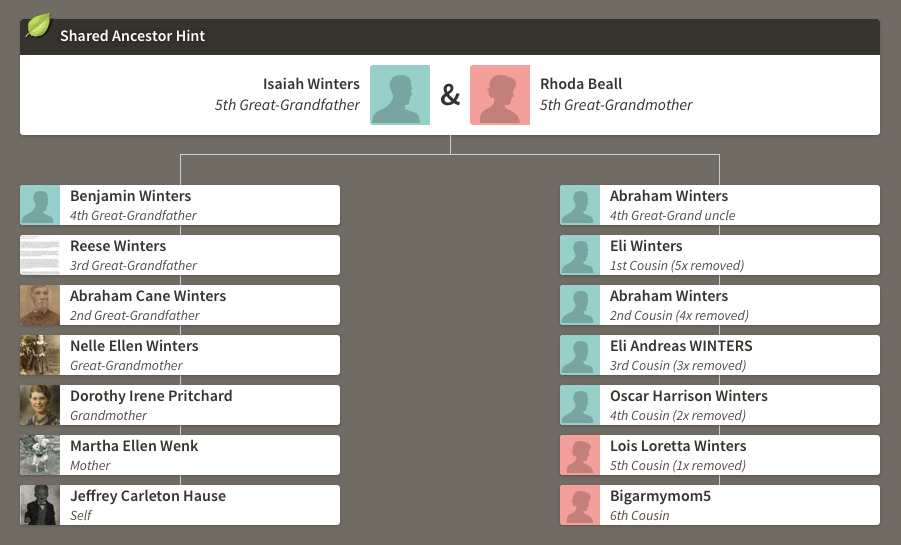 |
 Then I tried some other companies, offering other kinds of testing. GEDmatch is a free, non-profit, "do-it-yourself" genomics website that allows testers to upload raw data from FTDNA, AncestryDNA, and 23andMe to compare with a large database of data that has been voluntarily uploaded by other testers. This allowed me to take my AncestryDNA results, upload them to their server and compare them with different databases. They also use a slightly different algorithm for the comparison, so some additional matches could be available, as well as some different views of the comparisons. The GEDmatch site also provides tools for making 'deep' comparisons between genealogies and DNA test results to help identify possible hidden ancestral connections with distant cousins. This service is provided free to anybody.
Then I tried some other companies, offering other kinds of testing. GEDmatch is a free, non-profit, "do-it-yourself" genomics website that allows testers to upload raw data from FTDNA, AncestryDNA, and 23andMe to compare with a large database of data that has been voluntarily uploaded by other testers. This allowed me to take my AncestryDNA results, upload them to their server and compare them with different databases. They also use a slightly different algorithm for the comparison, so some additional matches could be available, as well as some different views of the comparisons. The GEDmatch site also provides tools for making 'deep' comparisons between genealogies and DNA test results to help identify possible hidden ancestral connections with distant cousins. This service is provided free to anybody.
For instance, it analyzed my DNA and determined that my parents shared no DNA segments, and were... therefore (thankfully)... unrelated. GEDmatch also has tools that can look far back in my family history:
 Shown above are my Eurogenes Proportions. This is derived from the Eurogenes K13 model (rev 21 Nov 2013) at http://www.GEDmatch.Com, created by Davidski (Polako). |
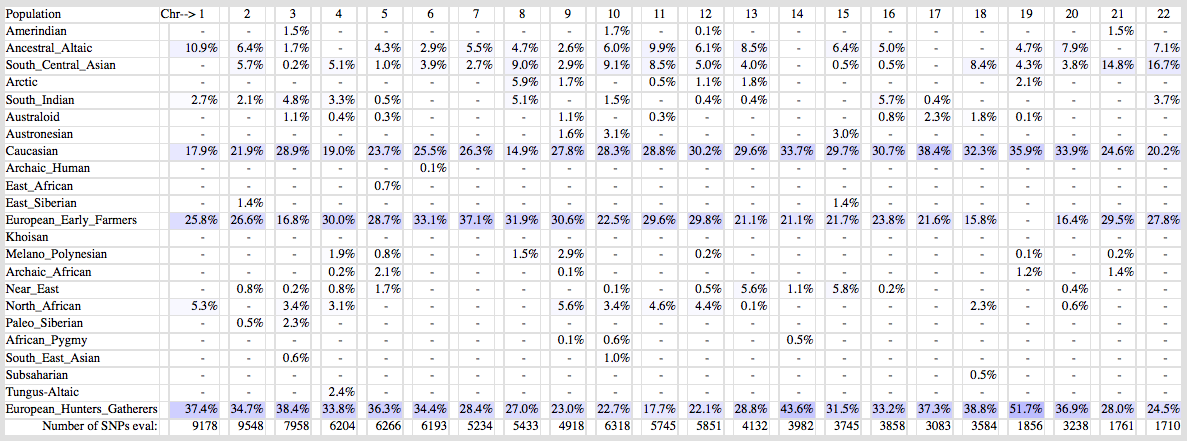 Shown above are my MDLP (Magnus Ducatus Lituaniae Project) K23b Admixture Proportions, a utility created by Vadim Verenich at http://www.GEDmatch.Com. It's a BGA analysis project for the territories of former Grand Duchy of Lithuania. |
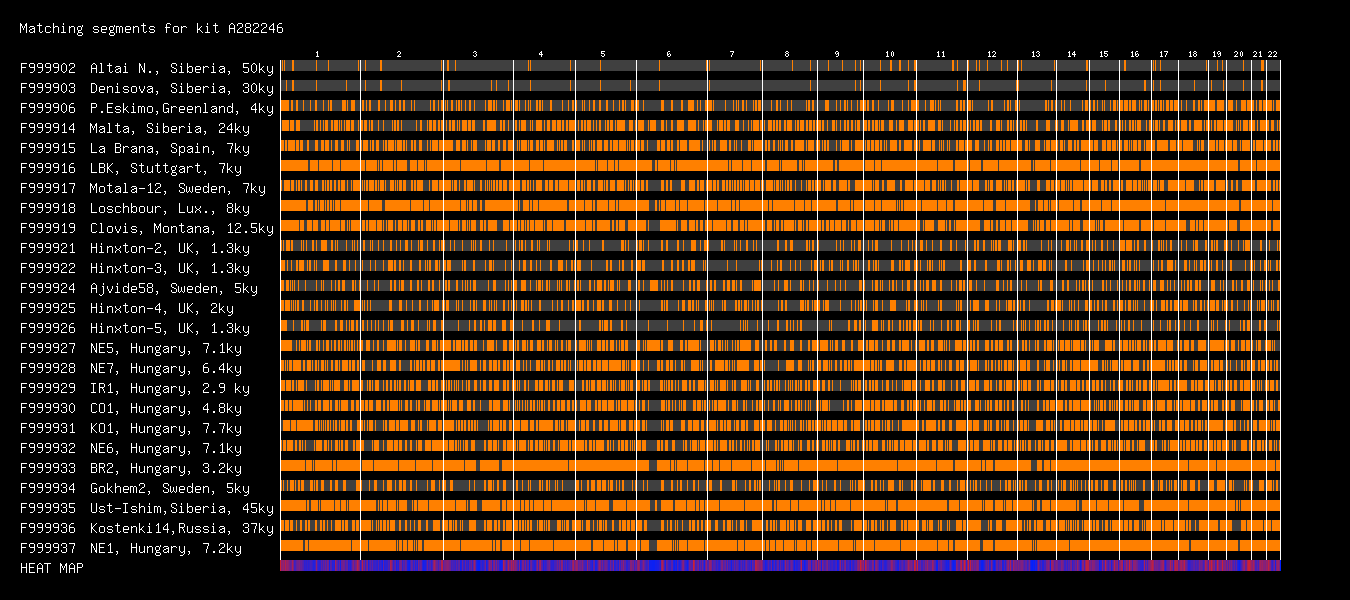 To my mother's surprise it turns out that my father and I are not descended from Neanderthals. My matches include a 7,500-year-old farmer from the Linearbandkeramik (LBK) culture from Stuttgart in Germany; an 8,000 year-old skeleton from the Loschbour rock shelter in Heffingen, Luxembourg; an Ancient Hungarian Bronze Age genome from 1.200 BC and a 7,200-year-old genome from Polgár-Ferenci-hát, Hungary; and most interestingly, a 12,000 year-old male infant (Anzick-1) recovered from the Anzick burial site in western Montana (click to enlarge). |
But atDNA tests can only find specific ancestral lineage beyond several generations by using correlating historical evidence (it's hard to connect somebody to a 12th or 13th cousin using DNA strands, because there is so much DNA from other ancestors swirling in our genetic soup).³
During the course of my years of research into my family history, I was beginning to have doubts about my lineage to JOHANN CHRISTIAN HAUß. The only connections I had to him were through the conclusions of other family historians, and not professional genealogists. There was no documented evidence—just the suppositions of other hobbyists, like myself. The lack of Haus/House matches on AncestryDNA didn't bother me, because I couldn't get alerted to matches with descendants of Johann Christian Hauß without linking myself directly to him in my family tree (which I couldn't honestly do without solid proof), and the service only alerts you when you have a confirmed match with another family tree. But by searching the database of surnames in each of my atDNA matches, I did find some who claimed that they were descended from Johann Christian Hauß. Here are three—one through Jurrian Hauß, another through a House in Herkimer County who was probably in Rheinhardt Hauß's line, and Christian's daughter, Anna Hauß:
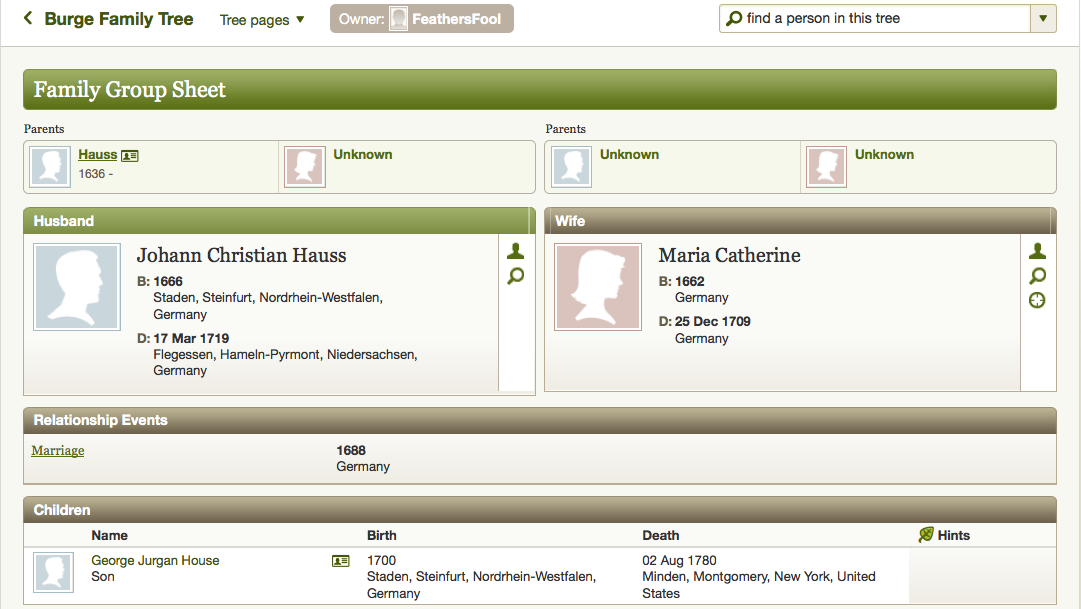 |
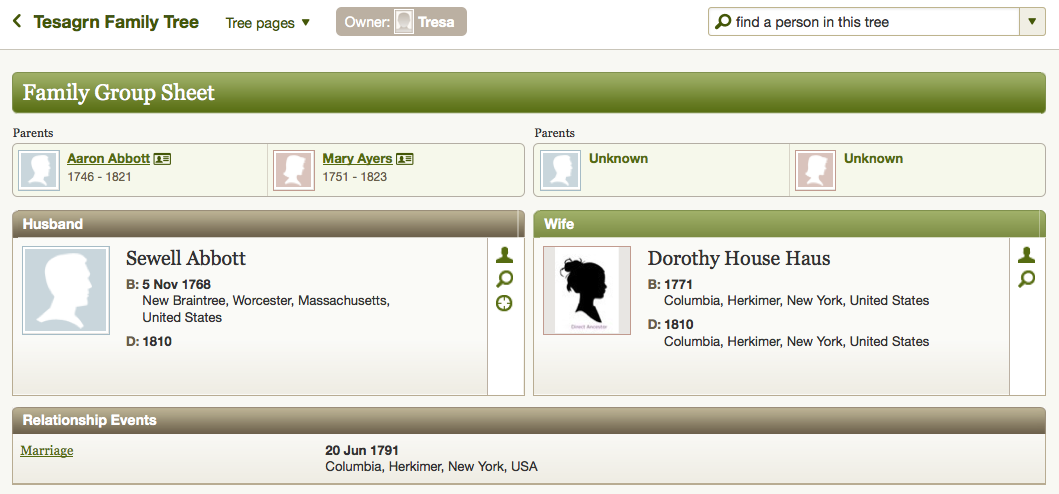 |
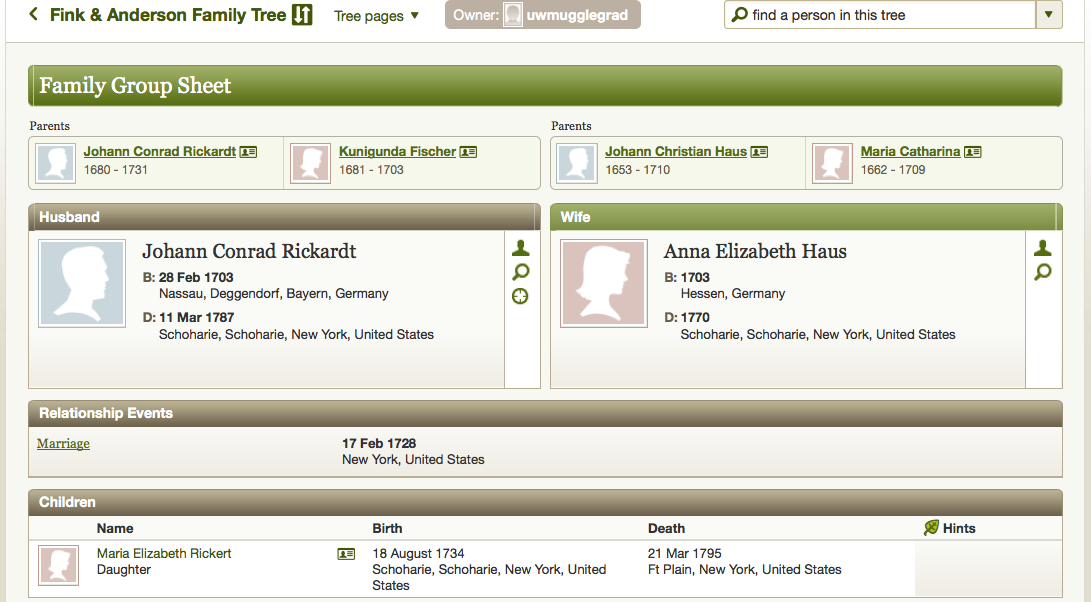 |
Another clue: a Hause cousin was matched with a man descended from Johannes Haus and Sarah Wheeler in the line of Johann Christian Hauß. That had to prove it, right? But wait, why didn't my DNA match up? Too any generations in between? Adoptions in my line? Gulp... bastardy?
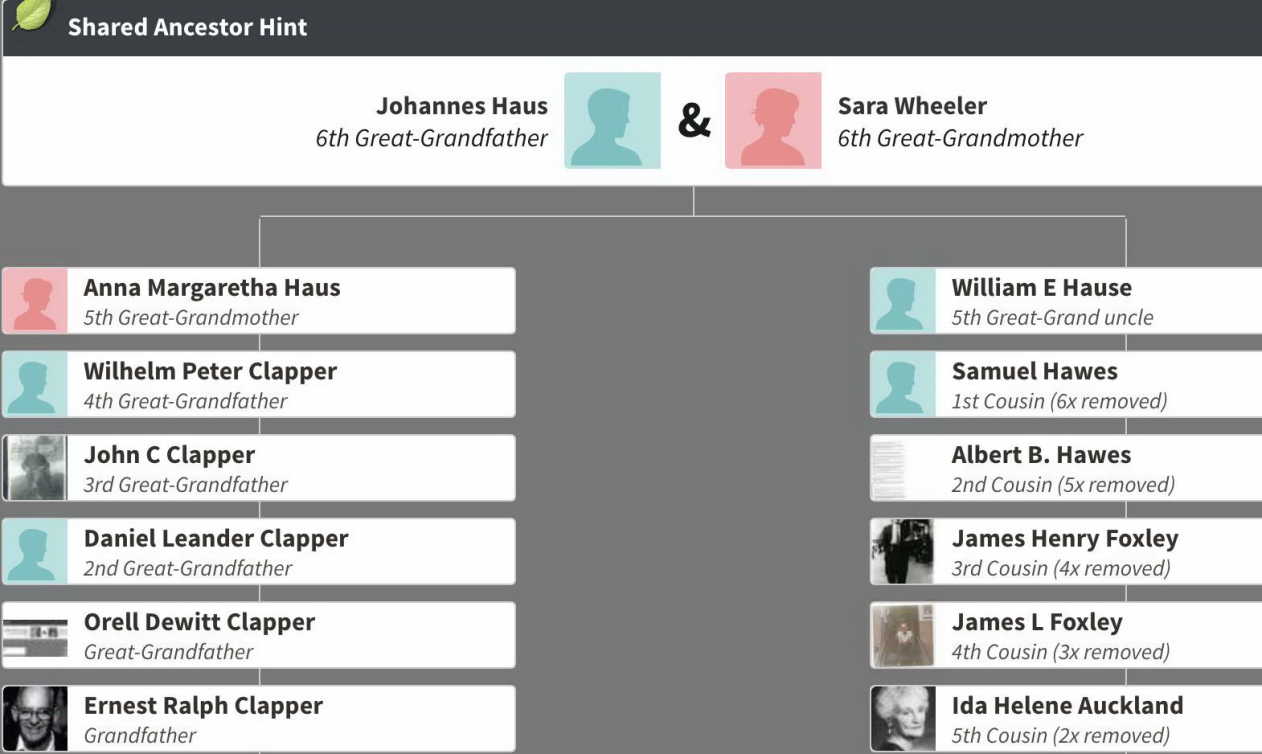 |
Unfortunately, these matches didn't actually prove anything, because the connection could be through different ancestors. For instance, two of the matches, above, also have the surname of Jones in their ancestry, so it could also be that I'm not really linked to them through a Hauß, but through one of my 4x great-grandmothers Jane Jones of New York or Sophia Jones of Kent, whose ancestries I haven't been able to trace, as yet. So the only way to prove or disprove my paternal ancestry from Johann Christian Hauß—a possible direct male ancestor from a dozen generations back—would be through a more specific Y-DNA test that would allow my results to be compared with the data from other males who claim direct descent.
... So now, the big reveal...
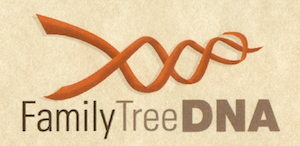 |
Late one night, I did some cheek-scraping for a buccal swab, and prepared myself (over the next eight loooooong weeks) to either confirm what had been assumed in other genealogical histories... or to disprove those theories and quickly undertake a massive rewrite of THIS family history before anybody else could check it on the Internet... I compared my Y-DNA to A) Bob Hause of Kansas, descended from William Hause, and to B) eight descendants of Johann Christian Hauß... and here are the results (I'll only show the first twelve STR markers, and the other males will remain anonymous), with my matches highlighted in white:
| Ancestor | Haplogroup | DYS393 | DYS390 | DYS19 | DYS391 | DYS385 | DYS426 | DYS388 | DYS439 | DYS389i | DYS392 | DYS389ii |
| Jeff Hause, U.S. | I-M223 | 14 | 23 | 15 | 10 | 14-16 | 11 | 13 | 11 | 14 | 12 | 32 |
| Bob Hause, U.S. | I-M223 | 14 | 23 | 15 | 10 | 14-16 | 11 | 13 | 11 | 14 | 12 | 32 |
| Johann Christian Hauß, (House) | R-M269 | 12 | 25 | 15 | 10 | 11-14 | 11 | 12 | 13 | 13 | 13 | 29 |
| Johann Christian Hauß, (House) | R-M269 | 12 | 25 | 15 | 10 | 11-14 | 11 | 12 | 13 | 14 | 13 | 30 |
| House (b. 1740), (House) | R-PF7563 | 12 | 25 | 15 | 10 | 11-14 | 11 | 12 | 13 | 14 | 13 | 30 |
| Johann Christian Hauß, (Howes) | R-M269 | 12 | 25 | 15 | 10 | 11-14 | 11 | 12 | 13 | 14 | 13 | 30 |
| Conradt A House, (Schramm) | R-M269 | 12 | 25 | 15 | 10 | 11-14 | 11 | 12 | 13 | 14 | 13 | 30 |
| Johann Christian Hauß, (House) | R-M269 | 12 | 25 | 15 | 10 | 11-14 | 11 | 12 | 13 | 14 | 13 | 30 |
| Johann Christian Hauß, (House) | R-M269 | 12 | 25 | 15 | 10 | 11-14 | 11 | 12 | 13 | 14 | 13 | 30 |
| Johann Christian Hauß, (House) | R-M269 | 12 | 25 | 15 | 10 | 11-14 | 11 | 12 | 13 | 14 | 13 | 30 |
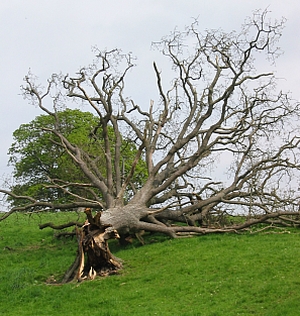 My family tree? "TIMBER!!!!!" |
However, the Haplogroup for eight people claiming to be descendants of Johann Christian Hauß (William's supposed great-grandfather) is R-M269 (the most common in Europe), not I-M223. Furthermore, Bob and I only match in 9 out of 37 STR markers with these Hauß progeny, meaning we are NOT actually related to them! (At least for twenty thousand years, anyway... and with a different haplogroup, we can add an extra couple hundred thousand years to that!)
Despite hundreds of online family trees, books, newspaper articles, and generations of assumed kinship, it looks like we are not descended from Johann Christian Hauß (at least in comparison to three samples at Family Tree DNA)! I'm at once thrilled and horrified to realize that the story that was the inspiration for this entire website might be apocryphal!!!
So... if our ancestor was not Johannes Hauß, then who was OUR John Hause? Because, by the way, Bob and I don't appear to be related to any other Hause/Hawes/House families in those surname projects, either:
| Ancestor | Haplogroup | DYS393 | DYS390 | DYS19 | DYS391 | DYS385 | DYS426 | DYS388 | DYS439 | DYS389i | DYS392 | DYS389ii |
| Jeff Hause, U.S. | I-M223 | 14 | 23 | 15 | 10 | 14-16 | 11 | 13 | 11 | 14 | 12 | 32 |
| Bob Hause, U.S. | I-M223 | 14 | 23 | 15 | 10 | 14-16 | 11 | 13 | 11 | 14 | 12 | 32 |
| Hanns Hauß, Germany | R-M269 | 13 | 24 | 14 | 10 | 11-14 | 13 | 12 | 11 | 13 | 13 | 29 |
| Peter Hawes, Germany | I-M170 | 13 | 23 | 15 | 10 | 12-14 | 11 | 13 | 12 | 12 | 11 | 29 |
| Edmond Hawes, England | I-M253 | 14 | 22 | 14 | 10 | 13-13 | 11 | 16 | 11 | 12 | 11 | 28 |
| Haws, Nether- lands |
R-M269 | 13 | 24 | 14 | 12 | 11-15 | 12 | 12 | 12 | 13 | 14 | 29 |
| Richard Hawes, Mass. | I-M253 | 13 | 24 | 14 | 10 | 14-14 | 11 | 12 | 11 | 12 | 11 | 28 |
| Hawes, Yorkshire | R-M269 | 13 | 24 | 14 | 10 | 11-14 | 12 | 12 | 12 | 13 | 13 | 29 |
"The first John Hause was born in Germany in the year 1690, and when an infant, on account of Religious Persecutions, he was transported by his 'cousin', Queen Mary II, of Great Britain, House of Stuart, Daughter of James II and Anne Hyde, born 1662, married William, Prince of Orange at the age of 17, reigning 15 years, and died in 1694 of Small Pox, leaving no children. A kind, meek, and noble Queen."
—Family Bible of Joseph Hause of Ovid, New York, mid-1800's.
So Bob and I don't match those descendants of Johann Christian Hauß, but how related are we to each other? Bob and I have always been told in family histories and by professional genealogists that our most recent common ancestor would be William Hause (1750-1818). I'm eight generations removed from him, and Bob is six generations removed. The results show that we are definitely related, no matter how much he'd like to deny it. We match in 12 out of the first 12 STA markers (which carries 99% confidence of sharing a common ancestor), and 24 out of the first 25 (better than 99% chance of a common ancestor) and 34 out of 37 STA markers. According to Family Tree DNA, a 34/37 match between two men who share a common surname means they definitely share a common male ancestor, but the exact range is hard to gauge without further testing. Still, the numbers on the right show an 89% probability that William would be our common paternal forefather.¹³ Of course, the TiP Report is a general guideline dealing in percentages, and not an absolute. Mutations can occur in bunches—or not occur for many generations—which can make matches look more distant or more close than they actually are.
The testing also turned up some surprise additions to the family:
| Ancestor | Haplogroup | DYS393 | DYS390 | DYS19 | DYS391 | DYS385 | DYS426 | DYS388 | DYS439 | DYS389i | DYS392 | DYS389ii |
| Jeff Hause, U.S. | I-M223 | 14 | 23 | 15 | 10 | 14-16 | 11 | 13 | 11 | 14 | 12 | 32 |
| Bob Hause, U.S. | I-M223 | 14 | 23 | 15 | 10 | 14-16 | 11 | 13 | 11 | 14 | 12 | 32 |
| Derek Foxley, U.S. | I-M223 | 14 | 23 | 15 | 10 | 14-16 | 11 | 13 | 11 | 14 | 12 | 32 |
|
Y-DNA TESTING UNCOVERS A NEW LINE OF HAUSE COUSINS |
| Family Tree DNA's Y-DNA testing also introduced me to a cousin who I never would have guessed was actually related. In May of 2016, I was contacted by Derek Foxley, who found out he was actually a Hause through Y-DNA testing, which matched his results with those of mine and with Bob Hause.There were Foxley's in the Hause House! It turns out that Derek's great-grandfather William Foxley was actually the son of Albert Hawes, a Civil War vet and old west outlaw from Wisconsin who died in a shootout in Utah in 1870. Through Y-DNA testing and Derek's own family research, we now know that Albert was the grandson of our common ancestor William Hause (1750-1818), through his son Samuel, who founded Dane, Wisconsin in the mid-1800s along with his brothers Matthew and Morris Hawes. (They were the youngest children of William, and the most ambitious of that generation, if not the worst name-spellers.) After Albert's death, his son James was adopted by the Foxleys and changed his name from James Hawes to William Foxley, to honor his new law-abiding parents. |
|
TiP COMPARISONS |
||||||||||||||||||||||||||||
|
The same goes with Dr. Bruce I. Bennett, descended from a man named Joseph Bennet, Sr., born in New Jersey in 1732 (in fact, there are twelve Bennetts on my match list in all with a Genetic Distance of "0" at 12 markers, and five with a Genetic Distance of "1"). There is a 91% probability that we had a common male ancestor in the last 24 generations; and four Brauns; and three Coomers; and Donald Ray Whitney, decended from Elijah Whitney (born abt. 1816). As the list of names grows, the world around me becomes much smaller.
Take, for example, an 18th cousin that I met through Family Tree DNA, named KITTY COOPER SMITH. She was notified of our DNA match and compared our family trees for a common ancestor in the predicted generation sample. After finding the first common ancestor, ROGER OF TRETOWER, Kitty put the relationship between Roger and me, and the relationship between Kitty and Roger on a relationship table.
|
In summation, I have all sorts of DNA evidence linking me to many fascinating ancestors... but as for my paternal origins, I have no idea—and in fact I'm more confused than ever. But would I recommend DNA testing? Heck, yeah! It's fun. And if you're related to me (especially if you're a Hause), maybe we can conclusively prove our true origins. But then, as my aunt says, "Whatever... Let me know when you trace us all back to Eve."
NOTES ON THIS PAGE:
¹—Although in truth DNA "fades" over time, as well. We don't have to look very far back in our family trees before we have more ancestors than we have sections of DNA—so the legacy of an ancestor several generations back may be too diluted to show up, while there are other ancestors from whom we have inherited no DNA at all!
²—The father of all men is 340,000 years old, published 13 March 2013 by Colin Barras in New Scientist magazine: "(Albert) Perry, recently deceased, was an African-American who lived in South Carolina. A few years ago, one of his female relatives submitted a sample of his DNA to a company called Family Tree DNA for genealogical analysis. Geneticists can use such samples to work out how we are related to one another. Hundreds of thousands of people have now had their DNA tested. The data from these tests had shown that all men gained their Y chromosome from a common male ancestor. This genetic "Adam" lived between 60,000 and 140,000 years ago. All men except Perry, that is. When Family Tree DNA's technicians tried to place Perry on the Y-chromosome family tree, they just couldn't. His Y chromosome was like no other so far analysed. Michael Hammer, a geneticist at the University of Arizona in Tucson, heard about Perry's unusual Y chromosome and did some further testing. His team's research revealed something extraordinary: Perry did not descend from the genetic Adam. In fact, his Y chromosome was so distinct that his male lineage probably separated from all others about 338,000 years ago... Digging deeper, Hammer's team examined an African database of nearly 6000 Y chromosomes and found similarities between Perry's and those in samples taken from 11 men, all living in one village in Cameroon. This may indicate where in Africa Perry's ancestors hailed from... The first anatomically modern human fossils date back only 195,000 years, so Perry's Y chromosome lineage split from the rest of humanity long before our species appeared."
³—To claim someone has 'Viking ancestors' is no better than astrology: Exaggerated claims from genetic ancestry testing companies undermine serious research into human genetic history, by Mark Thomas, professor of evolutionary genetics at University College London; published Monday 25 February 2013 10.41 EST, at guardian.co.uk. Also, DNA Ancestry Tests Are 'Meaningless' for Your Historical Genealogy Search: Commercial DNA tests can't tell us much about our specific ancestral lineage beyond several generations without other historical evidence, say scientists, by Ashik Siddique. Published Mar 07, 2013 06:00 PM EST, http://www.medicaldaily.com/articles/14210/20130307/dna-ancestry-tests-meaningless-genealogy-search.htm.
⁴—I may have also found a connection to another son of William's, through a line named "Hawes," as some of his sons spelled it. A man going by "cirrusce" from Scio, Oregon, is running a DNA account for a woman simply named "F.D" who is predicted to be related to me as a 4th-to-6th cousin. F.D. is descended from Samuel E. Hawes who lived in Dane County, Wisconsin, during the 1860s. The Hause (Hawes) family had a strong presence in Dane, Wisconsin. William's sons Matthew, Samuel and Morris Hawes all moved to Wisconsin in the early-to-mid 1800s, so it could be that Samuel was descended from one of them. William's son Samuel was born in 1794 and actually founded Dane, Wisconsin. There is a biography of his daughter in a book called "Biographical Review of Dane County, WI" (1893), Vol II, pp 617-619, which reads: "Lucy A. Hawes... was born near Seneca lake, NY, Sept. 15, 1827, and died on the old farm in Wisconsin, May 10, 1876. She was a daughter of Samuel and Catherine Hawes, natives respectively of New York and New Jersey. They came West in about 1849 or 1850, and the mother died in 1850, and the father is still living." I wonder if the unconnected Samuel in this line is actually Samuel Jr or Samuel III, or a nephew through one of the other brothers. Unfortunately, they have been been unable to trace her line past this Samuel E. Hawes, as he died between 1866 and 1873, when his wife Elsie had a son with a new husband named Andrew McCone, and the Hawes family history was lost. And being female, F.D. obviously can't take a Y-DNA test to see if we're related—so we may never know if my theory is correct. (UPDATE: Y-DNA has proven the match. We're related!)
⁵—One Common Ancestor Behind Blue Eyes, Jeanna Bryner, Livescience.com, dated 31 January 2008: "People with blue eyes have a single, common ancestor, according to new research. A team of scientists has tracked down a genetic mutation that leads to blue eyes. The mutation occurred between 6,000 and 10,000 years ago. Before then, there were no blue eyes. 'Originally, we all had brown eyes,' said Hans Eiberg from the Department of Cellular and Molecular Medicine at the University of Copenhagen."
⁶—Processed files from raw data can be downloaded from Google Drive-1 and Google Drive-2. You can use the Ancient Ancestry tool to compare your DNA with triangulated ancient DNA segments. Procedures used to convert sequence reads are discussed in the blog, Convert Ancient DNA Sequence Reads to VCF format. A posted opinion of its accuracy is on a blog at the accuracy of the ages of ancient DNA samples based on recent research in nuclear physics. The ages mentioned for each of the below ancient samples are based on what the original authors mentioned in their papers. Here are the sample categories:
| Sample Name | Sample Location | GEDMatch | Sex | Y-DNA | Mt-DNA | Approx. Age |
|---|---|---|---|---|---|---|
| Altai Neanderthal | Denisova Cave, Siberia | F999902 | Female | 50,000 years | ||
| Denisova | Denisova Cave, Siberia | F999903 | Female | 30,000 years | ||
| Palaeo-Eskimo | Qeqertarsuaq, Greenland | F999906 | Male | Q1a | D2a1 | 4,000 years |
| Clovis-Anzick-1 | Montana, North America | F999919 | Male | Q-Z780 | D4h3a | 12,500 years |
| Mal’ta | South-Central Siberia | F999914 | Male | R | U | 24,000 years |
| La Braña-Arintero | León, Spain | F999915 | Male | C-V183 | U5b2c1 | 7,000 years |
| Motala-12 | Östergötland, Sweden | F999917 | Male | I-L460 | U2e1 | 7,000 years |
| LBK | Stuttgart, Germany | F999916 | Female | T2c2 | 7,500 years | |
| Loschbour | Loschbour, Luxembourg | F999918 | Male | I-L460 | U5b1a | 8,000 years |
| Ajvide58 | Sweden | F999924 | Male | I-CTS772 | U4d | 5,000 years |
| Gökhem2 | Sweden | F999934 | Female | H1c | 5,000 years | |
| Hinxton-2 | Cambridgshire, UK | F999921 | Female | H2a2b1 | 1,300 years | |
| Hinxton-3 | Cambridgshire, UK | F999922 | Female | K1a4a1a2b | 1,300 years | |
| Hinxton-4 | Cambridgshire, UK | F999925 | Male | R-DF25 | H1ag1 | 2,000 years |
| Hinxton-5 | Cambridgshire, UK | F999926 | Female | H2a2a1 | 1,300 years | |
| KO1 | Tiszaszölös-Domaháza, Hungary | F999931 | Male | I-L68 | R3 | 5650-5780 cal BC |
| NE1 | Polgár-Ferenci-hát, Hungary | F999937 | Female | U5b2c | 5070-5310 cal BC | |
| NE5 | Kompolt-Kigyósér, Hungary | F999927 | Male | C-F3393 | J1c | 4990-5210 cal BC |
| NE6 | Apc-Berekalja I., Hungary | F999932 | Male | C-P255 | K1a3a3 | 4950-5300 cal BC |
| NE7 | Apc-Berekalja I., Hungary | F999928 | Male | I-L1228 | N1a | 4360-4490 cal BC |
| CO1 | Apc-Berekalja I., Hungary | F999930 | Female | H | 2700-2900 cal BC | |
| BR2 | Ludas-Varjú-dülö, Hungary | F999933 | Male | J-M67 | K1a1a | 1110-1270 cal BC |
| IR1 | Ludas-Varjú-dülö, Hungary | F999929 | Male | N-M231 | G2a1 | 830-980 cal BC |
| Tyrolean Iceman (ERP001144) | Tisenjoch Pass, Oetztal Alps | Male | 5,300 years | |||
| Ust'-Ishim | Ust'-Ishim, Siberia | F999935 | Male | K-M526 | R | 45,000 years |
| Kostenki14 | European Russia | F999936 | Male | C-V199 | U2b | 38,700-36,200 years |
⁷—The discovery of Ignanz's adoption could only come through a paper trail in Germany, because he's my maternal great-great grandfather and I don't have his Y-Chromosome. So I now would like to get two male Wenk cousins, descended from Ingnanz and his brother Joseph, to take Y-DNA tests to see if Ignanz was really a Wenk who was simply born before his parents could afford to get married (a common occurrance in Germany at that time). Are there any Wenks out there with some spare saliva?
⁸—Y-chromosome Haplogroup "I" includes about a quarter of all northwest European men. Its largest subgroup, I1a, is common in Scandinavia and Germany and occurs in Britain at a frequency of about 15%. However, there is some controversy as to whether I-M223 should properly be considered a subgroup of Haplogroup I1, or a separate Haplogroup I2 (I2b1 lineage), which likely has its roots in northern France (Resolving the Placement of Haplogroup I-M223 in the Y-Chromosome Phylogenetic Tree, by T. Whit Athey and Kenneth Nordtvedt; "Journal of Genetic Genealogy" No. 1, pp. 54-55, 2005). I2b1 lineage likely has its roots in northern France. Today it is found most frequently within Viking / Scandinavian populations in Northwest Europe and extends at low frequencies into Central and Eastern Europe.
The age of YSTR variation for the I-M223 subclade is 13.2₊2.7 kya⁹ and 12.3₊3.1 kya.¹⁰ I-M223 has a peak in Germany and another in eastern Sweden, but also appears in Romania/Moldova, Russia, Greece, Italy and around the Black Sea due to movement of Alans/Sarmatians/Scythians.¹¹ Haplogroup I2a2a has been found in over 4% of the population only in Germany, the Netherlands, Belgium, Denmark,probably moving tribes of Dacians. England (excluding Cornwall), Scotland, possibly descendants of the Iazyges, Legio VI Victrix, 175 410 AD, also the southern tips of Sweden and Norway in Northwest Europe; the provinces of Normandy, Maine, Anjou, and Perche in northwestern France; the province of Provence in southeastern France; the regions of Tuscany, Umbria, and Latium in Italy; Moldavia and the area around Russia's Ryazan Oblast and Republic of Mordovia in Eastern Europe maybe Agathyrsi, Khazars. Of historical note, both haplogroups I-M253 and I-M223 appear at a low frequency in the historical regions of Bithynia and Galatia in Turkey, possibly descendants of the Thracians, Cataphract of Alexander the Great at 334 BC, and Varangians, who are historically recorded to have invaded those parts of Anatolia from the 9th to 11th centuries. They ventured southwards along the rivers of Eastern Europe, connecting Scandinavia with Constantinople and Byzantine Empire.¹² Haplogroup I2a2a also occurs among approximately 1% of the Sardinians - Vandals. The subclade divergence for M223 occurred 14.6₊3.8 kya.⁹
Haplogroup I-M223 can be further subdivided in several subclades designated in the Y2012 ISOGG tree as follows: Haplogroup I-M223* with no further known polymorphisms, Haplogroup I-M284 defined by M284 polymorphism and including an undergroup Haplogroup I-L126 reserved for individuals derived for the L126/S165, L137/S166 polymorphisms, Haplogroup I-L701 associated with L701 polymorphism, and Haplogroup I-Z161 denoting individuals derived for the Z161 polymorphism.
⁹—Phylogeography of Y-Chromosome Haplogroup I Reveals Distinct Domains of Prehistoric Gene Flow in Europe, by Rootsi, Siiri et al., in "American Journal of Human Genetics" No. 75: pp. 128-137.
¹⁰—New phylogenetic relationships for Y-chromosome haplogroup I: Reappraising its Phylogeography and Prehistory, in Rethinking the Human Evolution, by Peter Underhill et al., ed. P. Mellars et al. (2007), pp. 33-42.
¹¹—Y chromosome diversity, human expansion, drift, and cultural evolution, by Jacques Chiaroni et al., PNAS (2009)
¹²—Vikings: Exploring Ancient Civilizations, by Tracey Ann Schofield, published by Teaching & Learning Co (November 1, 2002)
¹³—But there's another possibility. Bob and I are descended from different supposed sons of William Hause: I come from the supposed first son, John (1773-1844), while Bob comes from William, Jr. (1781-1825). The will of William Sr.'s father, John Hause (d. 1794), states: "The remaining part from my Estate I distribute in the following manner one quarter part to John Hause, (illegible), my grand son, son of Simon Haus and all the rest I give to my son William Haus." With that little tid-bit in mind, I go back to the family legend of William's brothers John and a Simon Hause dying side-by-side at the battle of White Plains, and to the "Simon Hawes" property in Ramapo on the military map used by George Washington. Am I actually descended from Simon Hause? Is the John Hause who William raised actually the son of his deceased brother?
In the early 1800s, William and most of his family moved from Ramapo to the Finger Lakes. My ancestor John Hause moved west with them, but settled in Ovid (at Hause Point), while William and sons William Jr., Simon, Joseph, etc., traveled another 30 miles, settling in Dundee (Hause Hill). The other brothers all established homesteads closer to William Sr. Was John breaking free from his father and brothers, or was he an orphaned nephew raised by William until he reached adulthood and followed his own path?
Additional testing (67 or 111 markers) by Bob and I (and hopefully other Hause cousins) can provide more definitive proof, as a match of 60 or more of 67 markers carries a >= 99% probability of sharing a common ancestor, and can confirm when our branches broke away. So anyway, all this is to say that DNA testing proves he and I share a common male ancestor, the MRCA probably being William Hause, or possibly his father John Hause. At least we can be sure of that. (I'm also a match with an ancestor of William's in-laws, the Wood family, so I may just be working myself up over a harmless mutation.)
 |